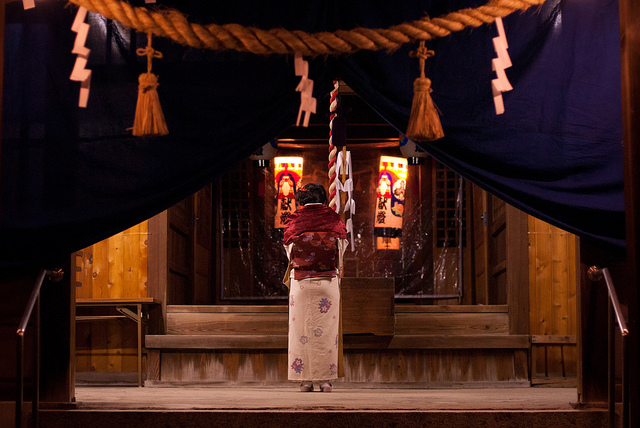
photo by Giyu
Usually it is rare to visit a shrine or temple. But, once a year on New Year’s Day, almost all Japanese head to the shrine or temple for Hatsumode for superstitious reasons. It is the first important event of the year, so be sure to learn the proper way to visit. It must be, that dreams come true for the people who are respectful when visiting, right?
Basically, what is ‘Hatsumode’?
‘Hatsumode’ is ‘visiting the local god to pray for the well-being of the family and sound health for the new year’. It is typical to go between January 1st and the 3rd, but that is not necessarily accurate. In reality, the time period to go for a Hatsumode visit is not determined and the first time that you visit is considered the hatsumode.
So, as long as your hatsumode is your first time visiting that year, it can be in February or even December.But if you go on New Years’, there are not only street vendors out so you can enjoy that festive feeling, but it must be a great feeling to know that you went at the beginning of the year.
Also, which is correct, to go to a shrine or a temple? Realistically, ‘either one is ok’. ‘What?’ would be your response, right? I will spare the details, but visiting either one is considered Hatsumode, so go and head to a close-by shrine or temple filled with appreciation for the the previous year and hope for the new year.
What to wear to a Hatsumode
Since you will be visiting a sacred location where there are gods, wear something that is not embarrassing. It is best to wear something formal such as a suit, but it’s OK if it’s not formal. It will leave a good impression with the gods if you don’t wear anything showing too much skin or is flashy. It is not acceptable to wear clothing with skull patterns or designs that are associated with death. For formal visitation at a higher classed shrine such as Ise Shrine, only top class formal wear is acceptable, so keep that in mind.
The correct way to visit a temple
- Bow once before the mountain gate, then enter.
- Clean your mouth and hands to purify your body at the purification trough.
- Ring the bell
There are many temples that prohibit the ringing of the bell by the general public, but if they allow it, be sure to do it. Ringing the bell after visitation is called ‘reversing the bell’ and is considered to be taboo so always be sure to do it before visiting.
-
Raise the candle and incense.
There are temples that don’t have candles or incense, but the smell of incense is said to entertain the Buddha so if they do have them available, be sure to light them. Lighting candles and incense from a fire lit by previous visitors is said to ‘receive sin’ and is considered bad luck, so don’t do it. - Once you enter the main building, make a money offering.
- Ring the temple gong
- Pray while putting your hands together in front of your chest.
- When done praying bow once.
Be careful not to clap like when at the shrine.
The correct way to visit a ‘shrine’
- Bow once before the gate and then enter.
- Walk the sides of the approach.
The center of the approach is where the gods pass so walk on the sides. - Clean your hands and mouth at the chozusha (purification trough).
<Manners at the chozusha>
Take the ladle with your right hand and scoop water onto your left hand to cleanse it.
Then take the ladle in your left hand from your right hand and cleanse your right hand.
Take the ladle again with your right hand and scoop water into your hand, and wash your mouth with that water.
Once you rinse your mouth, cleanse your left hand again.
Stand the used ladle so that the water runs to the dipper part to cleanse it, and then return the ladle to the original location. - Lightly bow once at the altar.
- Ring the bell.
- Offer a money offering.
The amount you offer is fine with what you decide. - 2 bows 2 claps 1 bow.
<2 bow 2 claps 1 bow etiquette>
Look towards the altar and bow deeply twice. (2 bows)Put your hands together at the level of your chest and clap them twice (2 claps)
Pray with your hands together at chest height. Bow deeply once (1 bow) - Walk the sides of the approach until you leave the gate.
- Once outside the gate, bow once.
Summary
There were many things that even Japanese people didn’t know, right? If visiting at the beginning of the year, it is best to visit the gods knowing proper visitation etiquette. Many shrines and temples have traditional Japanese architecture making many of them popular tourist destinations. Keeping proper visitation etiquette in mind, go and pray for the beginning of the new year while also sightseeing.
Related Article:
Know the differences between shrines and temples
